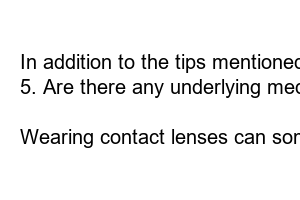안구건조증 치료 방법
Title: How to Treat Dry Eye Syndrome: Your Comprehensive Guide
Introduction:
Dry eye syndrome can be an uncomfortable and frustrating condition that affects millions of people worldwide. If you’re one of them, fret not! This blog post will provide you with valuable insights on how to effectively manage and treat dry eye syndrome. Let’s dive in!
1. Understanding Dry Eye Syndrome:
Dry eye syndrome occurs when your tears fail to provide adequate lubrication to your eyes. This can lead to symptoms such as stinging, burning, redness, and blurred vision. Knowing the causes, including prolonged screen time, aging, and certain medical conditions, can help in developing an appropriate treatment plan.
2. Don’t Forget to Blink:
*Blinking regularly* is crucial in keeping your eyes moist. Many of us tend to blink less when staring at screens, causing evaporation of tears. **Consciously blinking** can provide much-needed relief by spreading tears across the surface of the eyes.
3. Artificial Tears for Instant Relief:
One of the simplest ways to combat dry eyes is to use *over-the-counter artificial tears*. These lubricating eye drops can effectively alleviate symptoms by replenishing the moisture your eyes need. Make sure to choose preservative-free options for prolonged use.
4. Improve Indoor Air Quality:
Dry eyes can worsen in environments with low humidity levels. Enhance indoor air quality by using a humidifier, especially during winter when heating systems are in use. This helps maintain a comfortable level of moisture in the air, preventing excessive evaporation of tears.
5. Follow the 20-20-20 Rule:
Prevent dry eye symptoms caused by extended screen time by following the *20-20-20 rule*. Every 20 minutes, take a 20-second break and focus on an object at least 20 feet away. This exercise helps relieve eye strain and encourages proper blinking.
6. Adjust Your Environment:
Making small adjustments to your surroundings can significantly alleviate dry eye symptoms. Position your computer screen below eye level to help your eyelids cover a greater area when blinking. Additionally, ensure proper lighting and reduce glare from windows or lights to ease eye strain.
7. Seek Professional Advice:
If your dry eye symptoms persist or worsen, it’s essential to consult an optometrist or ophthalmologist. These professionals can evaluate your condition, provide specialized treatments, and recommend long-term strategies tailored to your needs.
Summary:
In summary, managing and treating dry eye syndrome requires a multi-faceted approach. By incorporating simple lifestyle changes, using artificial tears, and seeking professional guidance, you can alleviate discomfort and improve your overall eye health. Remember to blink frequently, follow the 20-20-20 rule, and make adjustments to your environment for maximum relief. Don’t let dry eye syndrome dampen your spirits. Take charge and enjoy optimal eye comfort!
FAQs:
1. Can dry eye syndrome be cured completely?
While dry eye syndrome may not have a permanent cure, its symptoms can be effectively managed and treated through various methods.
2. How long does it take to see improvements with artificial tears?
Artificial tears can provide immediate relief, but long-term usage may be required for consistent improvement in dry eye symptoms.
3. Is dry eye syndrome more common in certain age groups?
Yes, dry eye syndrome is more prevalent in older individuals, particularly those above the age of 50. However, it can affect people of all ages.
4. Are there any home remedies for dry eye syndrome?
In addition to the tips mentioned in this article, applying warm compresses to the eyes and maintaining proper hydration can offer relief from dry eye symptoms.
5. Are there any underlying medical conditions associated with dry eye syndrome?
Yes, conditions like diabetes, thyroid disorders, and autoimmune diseases can contribute to dry eye syndrome.
6. Can wearing contact lenses worsen dry eye symptoms?
Wearing contact lenses can sometimes exacerbate dry eye symptoms. Consult with your eye care professional for suitable options, such as moisture-retaining lenses or switching to glasses when necessary.

